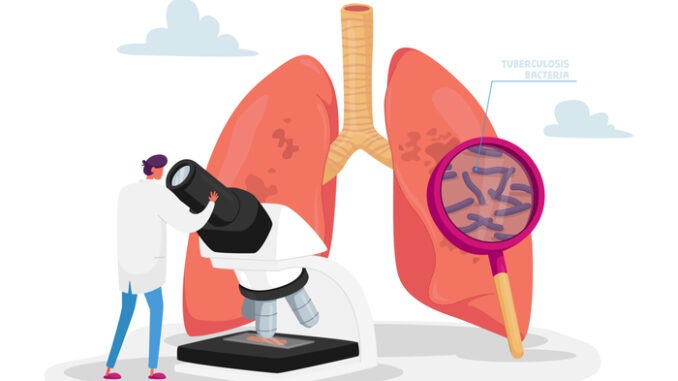
Tuberculosis has a long and interesting history. Medicine has managed to exercise a measure of control over this deadly disease, but its story is far from over
Tuberculosis (TB) is an infection caused by mycobacterium tuberculosis. It’s potentially serious and is spread through minute droplets released into the air by coughing and sneezing – it mainly affects the lungs.
It’s been around and known for a long time. The Ancient Greeks called it Phthisis and Hippocrates accurately described its characteristic lung changes and identified it as fatal. During the Roman era, the physician Galen wrote of the symptoms of TB as ‘fever, sweating, coughing and blood-stained sputum’ while, in the Middle Ages, TB was described as the ‘king’s evil’ and it was widely believed that it could be cured by a royal touch – the custom was stopped by George I. The pulmonary disease had, by this time, been linked with a disease affecting the lymph nodes in the neck called scrofula.
The term ‘tuberculosis’ was first coined in the mid-nineteenth century when TB was ravaging Europe. In the 18th and 19th centuries, one person in every 1,000 was dying each year from the disease. The problem was compounded by the industrial revolution where people lived in overcrowded social conditions with primitive sanitation, malnutrition and appalling work settings. Reports suggest that, in the late 1830s, a third of English tradesmen and labourers, and a sixth of the upper classes, died of the disease. By the middle of the 19th century, the benefits of healthy eating and fresh air were recognised, and clinics developed in Alpine and other towns.
The infective nature of the disease was recognised by Albert Klebs, who cultured mobile bacilli in egg in 1867. Robert Koch isolated the bacillus itself, cultivating it and proving its infectious nature by reproducing the disease in laboratory animals. From this point on strides were made in diagnosis and treatment. Albert Calmette and Camille Guérin produced the Bacille Calmette Guérin (BCG) vaccine after the first world war, following the formulation of the Mantoux Test to assess sensitivity to the bacterium.
The disease is now much less common than it was. The number of people found to have the disease in the UK has steadily fallen over the last thirty years from about 11,000 in 1971 to under half that number. However, in 2019, there was a UK rise of nearly 2.5% in the number of cases. Nearly a third of these cases were in London and the rate of infection for the most deprived 10% of the population was five times that of the least deprived 10%; cases in non-white ethnic groups were over ten times higher than those in white ethnic groups.
Symptoms and treatment
TB may cause no symptoms if an individual is carrying inactive bacteria; this is called latent TB. If the infection makes the person ill, it’s called active TB. The signs and symptoms of active TB include:
- Persistent cough, productive of blood or mucus.
- Chest pain associated with coughing or even with breathing.
- Fever and night sweats.
- Weight loss.
- Loss of appetite.
The disease may spread to involve other parts of the body, including the spine, the kidneys and the brain.
TB is more common in patients with weakened immune systems – such as those with HIV/AIDS, those receiving cancer chemotherapy, IV drug users and healthcare professionals who treat patients with the disease. Although TB is contagious, it’s not easily caught and those who contract it generally acquire it from close friends, relatives or workmates.
If a patient is suspected of having TB a chest X-ray may show typical changes, and a sample of expectorate (phlegm) can be cultured to check for the production of mycobacteria. Other tests may include a CT or MRI scan or a bronchoscopy which involves the passage of an endoscope into the lung to visualise and biopsy samples of lung tissue suspected of being tuberculous.
In cases where the disease is latent, it is important to test for TB despite the absence of symptoms. The Mantoux Test is widely used and involves injecting a very small quantity of a tuberculous antigen (tuberculin) into the forearm. The arm of an individual with latent TB will develop a small raised red reaction, normally within three days. Anyone with a clearly positive reaction should undergo a chest X-ray. If the individual does not have latent TB, there should be little or no reaction to the tuberculin. A newer test, the IGRA, is on its way.
The treatment of TB has had a considerable impact on the health of many societies over the years. In the 1880s sanitoria developed over Europe and America and the search was on for treatment. In 1945 the antibiotic streptomycin was introduced; resistance to the drug quickly developed but its combination with para-aminosalicylic acid (PAS), also discovered in 1945, reduced the occurrence of resistance. In 1952, isoniazid was introduced and was safe and well-tolerated.
In the 1970s ethambutol replaced the less well-tolerated PAS and, along with rifampicin, rapidly became a cornerstone of treatment. These two drugs, plus isoniazid and pyrazinamide, now form the group of agents most commonly used. Treatment with combination therapy normally lasts for six-to-nine months but, unfortunately, some forms of TB are developing resistance to these drugs too. There are some newer agents which can be used in resistant cases, including bedaquiline and delamanid, but treatment for up to two years, or even longer, may be needed.
Calmette and Guérin’s successful vaccine BCG was a game-changer; in the UK it’s recommended for babies, children and adults under 35 and for at-risk groups. Globally, 4½ billion people are estimated to have been vaccinated since its introduction. However, TB remains a major problem in parts of the world such as Africa, India, Pakistan Bangladesh, South America and parts of Russia and China – it still kills up to 2,000,000 people a year so, sadly, the story of TB is not yet over.


Be the first to comment